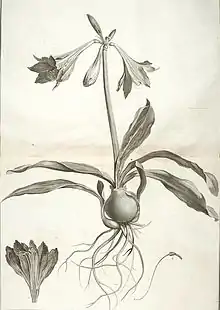Hippeastrum reticulatum
Hippeastrum reticulatum, the netted-veined amaryllis, is a flowering perennial herbaceous bulbous plant, in the family Amaryllidaceae, native to South America.[1]
| Hippeastrum reticulatum | |
|---|---|
.jpg.webp) | |
| Scientific classification | |
| Kingdom: | Plantae |
| Clade: | Tracheophytes |
| Clade: | Angiosperms |
| Clade: | Monocots |
| Order: | Asparagales |
| Family: | Amaryllidaceae |
| Subfamily: | Amaryllidoideae |
| Genus: | Hippeastrum |
| Species: | H. reticulatum |
| Binomial name | |
| Hippeastrum reticulatum | |
| Synonyms | |

.jpg.webp)
Description
Originally described by L'Héritier as petalis venosis transversal distincta,[4] a reference to the defining characteristic of the species with an unusual and exquisite venation of the petals, darker than the purple to pink background color. The seeds are unusual for Hippeastrum in being orange-red, round, turgid and fleshy rather than black and paper like.[5][6]
Taxonomy
Hippeastrum reticulatum was one of the earliest Hippeastrums to be discovered and was introduced to Europe in 1777 by Edward Whitaker Gray from Brazil,[5] as documented by William Aiton in his Hortus Kewensis (1789).[7] It was described by Charles Louis L'Héritier de Brutelle in 1788 as one of a number of species of Amaryllis, Amaryllis reticulata,[4][8] it was later recognised by Herbert in 1824 as a member of the separate South American genus Hippeastrum rather than Amaryllis which is confined to South Africa, and thus as Hippeastrum reticulatum (L'Hér.) Herb., Bot. Mag. 51: t. 2475 (1824).[9][1][10]
Subdivision
Some sources[5] follow Herbert (1837) in stating that there are two varieties, reticulatum and striatifolium.[11][8][6] A third variety, strictum Herb., is sometimes also included.[10] This division into varieties is not accepted by the World Checklist.[12]
Etymology
The specific epithet reticulatum is Latin for "netted", referring to the venation of the petals.[13]
Distribution and habitat
From Argentina to Brazil,[1][6] growing in wet sandy soil. In Brazil they are found under Mussununga forest whose smaller canopy allows more light to reach the forest floor.[5]
Ecology
Hippeastrum reticulatum blooms in late summer to autumn, with an active growing season of autumn to early winter, and requires a semi-dormant period of 4–6 weeks during late winter and early spring. The species is unusual amongst Hippeastrum, in being self-fertile.[5][6]
References
- WCLSPF 2015, Hippeastrum reticulatum
- WCLSPF 2015, Synonyms
- TPL 2013.
- L'Héritier de Brutelle 1788, Plate 14
- PBS 2015, Hippeastrum reticulatum
- IBS 2013.
- Aiton 1789, Amaryllis reticulata p. 225
- Herbert 1819.
- Herbert 1824.
- Tropicos 2016.
- Herbert 1837, Hippeastrum reticulatum striatifolium p. 137
- WCLSPF 2015, Hippeastrum reticulatum var. striatifolium (Herb.)
- Griffith 2005.
Bibliography
Historical
- Aiton, W. (1789). Hortus Kewensis 3 vols. London: George Nicol.
- Herbert, W. (1819). "Amaryllis reticulata. β. striatifolia Griffin's netted-veined Amaryllis. Coburgia. Herbert". Curtis's Botanical Magazine. 47: T. 2113 1–6.
- Herbert, W. (1824). "Amaryllis subbarbatum. Slightly-bearded Knights-star-lily". Curtis's Botanical Magazine. 51: T. 2475 1–2.
- Herbert, William (1837). Amaryllidaceae: Preceded by an Attempt to Arrange the Monocotyledonous Orders, and Followed by a Treatise on Cross-bred Vegetables, and Supplement. London: Ridgway.
- L'Héritier de Brutelle, Charles Louis (1788). Sertum Anglicum, seu, Plantae rariores quae in hortis juxta Londinum: imprimis in horto regio Kewensi excoluntur, ab anno 1786 ad annum 1787 observatae. Paris: Petri Francisci Didot.
Databases
- GBIF: Hippeastrum reticulatum
- "Hippeastrum reticulatum Herb". Tropicos. Missouri Botanical Garden. 2016. Retrieved 1 May 2016.
- The Plant List (2013). "Hippeastrum reticulatum (L'Hér.) Herb". Retrieved 20 March 2014.
- "World Checklist of Selected Plant Families". Royal Botanic Gardens, Kew. Retrieved 8 August 2015.
Flora
- Zuloaga, Fernando O.; Morrone, Osvaldo; Belgrano, Manuel J., eds. (2008). "Hippeastrum". Catálogo de las plantas vasculares del Cono Sur: (Argentina, Sur de Brasil, Chile, Paraguay y Uruguay) (Monogr. Syst. Bot. Missouri Bot. Gard. 107). St. Louis, Mo.: Missouri Botanical Garden. ISBN 978-1-930723-70-2.
- Maia, Leonor Costa (2016). "Lista de Espécies da Flora do Brasil". INCT – Herbário Virtual da Flora e dos Fungos. Recife: Institutos Nacionais de Ciência e Teconologia. Retrieved 2 May 2016.
- "Brazilian Flora 2020". Reflora. Flora do Brasil 2020. Institute of Research, Rio de Janeiro Botanical Garden. 2016. Retrieved 5 May 2016.
- "INCT – Herbário Virtual da Flora e dos Fungos" (in Portuguese and English). Institutos Nacionais de Ciência e Teconologia. 2016. Retrieved 7 May 2016.
Other
- Griffith, Chuck (2005). "reticulatus". Dictionary of Botanical Epithets. Retrieved 29 April 2016.
- "Pacific Bulb Society Wiki". Pacific Bulb Society. 2015.
- Tsang, Dennis. "Hippeastrum reticulatum var. striatifolium". Gallery of the World's Bulbs. International Bulb Society. Archived from the original on 4 December 2013. Retrieved 3 May 2016.